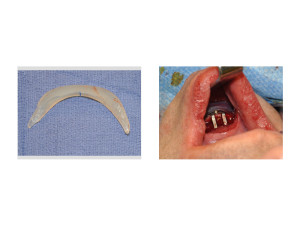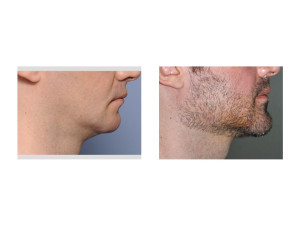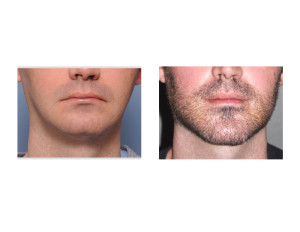Background: Lower jaw deficiencies are most commonly perceived as being of the horizontal variety. A short chin invokes the need for horizontal chin augmentation and this certainly is the most common jaw augmentation procedure. It is also the simplest and most easily performed. But jaw deficiences can occur in other dimensions as well and their diagnosis and treatment require a greater understanding and surgical expertise to treat.
Vertical jaw deficiences usually present with a visible shortening of the lower third of the face. Other clinical findings include a very flat mandibular plane angle, some percentage of dental overbite at the incisors and downturning of the corners of the mouth. Patients usually know how to make their lower jaw look better by opening their mouth a bit vertically to create a longer jaw.
The hardest dimension to change in the lower jaw is the vertical one. This is why vertical jawline augmentation is rarely written about or discussed. While the chin can be vertically changed by using one’s own bone through an opening wedge bony genioplasty, the ramus and body of the mandible must be vertically elongated by implants. Since there are no preformed vertical lengthenng jaw implants other than that of the chin, custom implants must be made for vertical change in the back of the jaw.
Case Study: This 23 year old male had a vertical jaw deficiency that he camouflaged by opening his mouth slightly. He felt that this made his face look better along his entire jawline as well as around his mouth. Measuring the vertical change at his incisors between when he occluded completely and when he felt he looked the best was 7mms.


Vertical lengthening of the entire lower third of the face can be done by either the three piece combined autologous/alloplastic approach as in this patient or it can be done by a complete custom implant. Each has their own advantages and disadvantages with the custom approach being more unified but also being more costly.
Highlights:
1) Lower jaw deficiencies can occur in the vertical dimension as well as in horizontal under development.
2) Vertical jaw deficiencies must be treated differently using vertical lengthening sliding genioplasties, vertical lengthening jaw angle implants or vertical lengthening custom total jawline implants.
3) Management of the chin determines the total overall approach to the type of vertical jawline augmentation done.
Dr. Barry Eppley
Indianapolis, Indiana



